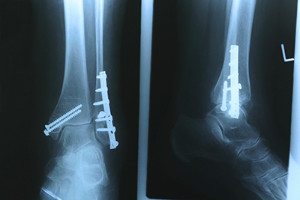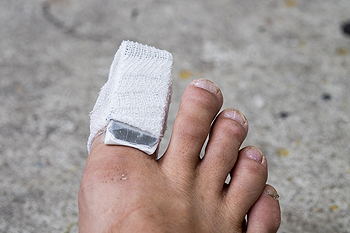Connect With Us
Blog
Items filtered by date: February 2020
How Can You Prevent a Blister From Forming?
Blisters may be characterized as fluid-filled sacs that form due to friction between the foot and tightly worn socks or shoes. Some blisters may also form due to a burn or injury. To help prevent a blister from developing, it is recommended that your footwear is neither too big nor too small, as that may increase rubbing between your foot and shoe. For runners especially, it is important that you change your running shoes about every 6 months to ensure a proper fit. Some patients have found keeping their feet dry by using a foot powder has been effective in preventing blisters as well. For extra support, you may want to try doubling your socks, or taping areas that are more susceptible to getting blisters, such as the back of the heel or your toes. For more advice on the treatment and prevention of blisters it is suggested that you speak with a podiatrist for professional care.
Blisters are prone to making everyday activities extremely uncomfortable. If your feet are hurting, contact Tanisha Richmond, DPM of Richmond Foot & Ankle, LLC. Our doctor can provide the care you need to keep you pain-free and on your feet.
Foot Blisters
Foot blisters develop as a result of constantly wearing tight or ill-fitting footwear. This happens due to the constant rubbing from the shoe, which can often lead to pain.
What Are Foot Blisters?
A foot blister is a small fluid-filled pocket that forms on the upper-most layer of the skin. Blisters are filled with clear fluid and can lead to blood drainage or pus if the area becomes infected.
How Do Blisters Form?
Blisters on the feet are often the result of constant friction of skin and material, usually by shoe rubbing. Walking in sandals, boots, or shoes that don’t fit properly for long periods of time can result in a blister. Having consistent foot moisture and humidity can easily lead to blister formation.
Prevention & Treatment
It is important to properly care for the affected area in order to prevent infection and ease the pain. Do not lance the blister and use a Band-Aid to provide pain relief. Also, be sure to keep your feet dry and wear proper fitting shoes. If you see blood or pus in a blister, seek assistance from a podiatrist.
If you have any questions, please feel free to contact our office located in Dayton, OH . We offer the newest diagnostic and treatment technologies for all your foot care needs.
Reminder: When Was the Last Time...?
Do I Have a Stress Fracture?
 A hairline fracture that gradually occurs may be defined as a stress fracture. It can happen as a result of frequently running or participating in sporting activities, and is known to develop from overuse. If a stress fracture is not promptly treated, it will typically get worse as the activity continues. The common symptoms that are associated with this condition may include swelling, pain and discomfort surrounding the affected area, and it may be difficult to walk. Factors that may lead to the development of a stress fracture can consist of wearing shoes that do not fit correctly, running on hard or uneven surfaces, or existing medical conditions such as osteoporosis. Relief may be obtained by elevating the affected foot, as this may help to reduce swelling. If you have endured a stress fracture it is suggested that you schedule a consultation with a podiatrist as quickly as possible, so proper treatment can begin.
A hairline fracture that gradually occurs may be defined as a stress fracture. It can happen as a result of frequently running or participating in sporting activities, and is known to develop from overuse. If a stress fracture is not promptly treated, it will typically get worse as the activity continues. The common symptoms that are associated with this condition may include swelling, pain and discomfort surrounding the affected area, and it may be difficult to walk. Factors that may lead to the development of a stress fracture can consist of wearing shoes that do not fit correctly, running on hard or uneven surfaces, or existing medical conditions such as osteoporosis. Relief may be obtained by elevating the affected foot, as this may help to reduce swelling. If you have endured a stress fracture it is suggested that you schedule a consultation with a podiatrist as quickly as possible, so proper treatment can begin.
Stress fractures occur when there is a tiny crack within a bone. To learn more, contact Tanisha Richmond, DPM from Richmond Foot & Ankle, LLC. Our doctor can provide the care you need to keep you pain free and on your feet.
How Are They Caused?
Stress fractures are the result of repetitive force being placed on the bone. Since the lower leg and feet often carry most of the body’s weight, stress fractures are likely to occur in these areas. If you rush into a new exercise, you are more likely to develop a stress fracture since you are starting too much, too soon. Pain resulting from stress fractures may go unnoticed at first, however it may start to worsen over time.
Risk Factors
- Gender – They are more commonly found in women compared to men.
- Foot Problems – People with unusual arches in their feet are more likely to develop stress fractures.
- Certain Sports – Dancers, gymnasts, tennis players, runners, and basketball players are more likely to develop stress fractures.
- Lack of Nutrients – A lack of vitamin D and calcium may weaken the bones and make you more prone to stress fractures
- Weak Bones – Osteoporosis can weaken the bones therefore resulting in stress fractures
Stress fractures do not always heal properly, so it is important that you seek help from a podiatrist if you suspect you may have one. Ignoring your stress fracture may cause it to worsen, and you may develop chronic pain as well as additional fractures.
If you have any questions, please feel free to contact our office located in Dayton, OH . We offer the newest diagnostic and treatment technologies for all your foot care needs.
Why Live with Pain and Numbness in Your Feet?
How to Treat a Broken Toe
 Common symptoms indicating you may have broken your toe can include severe pain and discomfort on and around the affected toe, as well as bruising or swelling. It typically occurs as a result of a heavy object falling on the toe, or if it is stubbed against a piece of furniture. Despite the obvious diagnosis, it is recommended that an X-ray be performed to positively confirm the toe has been broken. An effective treatment method can include a procedure that is referred to as buddy taping. This involves taping the injured toe to the toe next to it. This can help to provide the necessary stability that is needed as the healing process takes place. If you have broken your toe, it is suggested that you consult with a podiatrist who can determine the extent of the injury, in addition to offering you correct treatment options.
Common symptoms indicating you may have broken your toe can include severe pain and discomfort on and around the affected toe, as well as bruising or swelling. It typically occurs as a result of a heavy object falling on the toe, or if it is stubbed against a piece of furniture. Despite the obvious diagnosis, it is recommended that an X-ray be performed to positively confirm the toe has been broken. An effective treatment method can include a procedure that is referred to as buddy taping. This involves taping the injured toe to the toe next to it. This can help to provide the necessary stability that is needed as the healing process takes place. If you have broken your toe, it is suggested that you consult with a podiatrist who can determine the extent of the injury, in addition to offering you correct treatment options.
A broken toe can be very painful and lead to complications if not properly fixed. If you have any concerns about your feet, contact Tanisha Richmond, DPM from Richmond Foot & Ankle, LLC. Our doctor will treat your foot and ankle needs.
What to Know About a Broken Toe
Although most people try to avoid foot trauma such as banging, stubbing, or dropping heavy objects on their feet, the unfortunate fact is that it is a common occurrence. Given the fact that toes are positioned in front of the feet, they typically sustain the brunt of such trauma. When trauma occurs to a toe, the result can be a painful break (fracture).
Symptoms of a Broken Toe
- Throbbing pain
- Swelling
- Bruising on the skin and toenail
- The inability to move the toe
- Toe appears crooked or disfigured
- Tingling or numbness in the toe
Generally, it is best to stay off of the injured toe with the affected foot elevated.
Severe toe fractures may be treated with a splint, cast, and in some cases, minor surgery. Due to its position and the pressure it endures with daily activity, future complications can occur if the big toe is not properly treated.
If you have any questions please feel free to contact our office located in Dayton, OH . We offer the newest diagnostic and treatment technologies for all your foot and ankle needs.
Read more about What to Know About a Broken ToeBlog Archives
- March 2025
- February 2025
- January 2025
- December 2024
- November 2024
- October 2024
- September 2024
- August 2024
- July 2024
- June 2024
- May 2024
- April 2024
- March 2024
- February 2024
- January 2024
- December 2023
- November 2023
- October 2023
- September 2023
- August 2023
- July 2023
- June 2023
- May 2023
- April 2023
- March 2023
- February 2023
- January 2023
- December 2022
- November 2022
- October 2022
- September 2022
- August 2022
- July 2022
- June 2022
- May 2022
- April 2022
- March 2022
- February 2022
- January 2022
- December 2021
- November 2021
- October 2021
- September 2021
- August 2021
- July 2021
- June 2021
- May 2021
- April 2021
- March 2021
- February 2021
- January 2021
- December 2020
- November 2020
- October 2020
- September 2020
- August 2020
- July 2020
- June 2020
- May 2020
- April 2020
- March 2020
- February 2020
- January 2020
- December 2019
- November 2019
- October 2019
- September 2019
- August 2019
- July 2019
- June 2019
- May 2019
- April 2019
- March 2019
- February 2019
- January 2019
- December 2018
- November 2018


